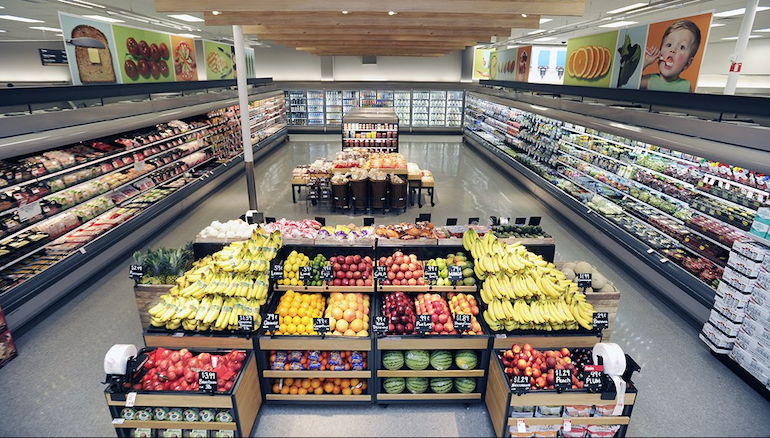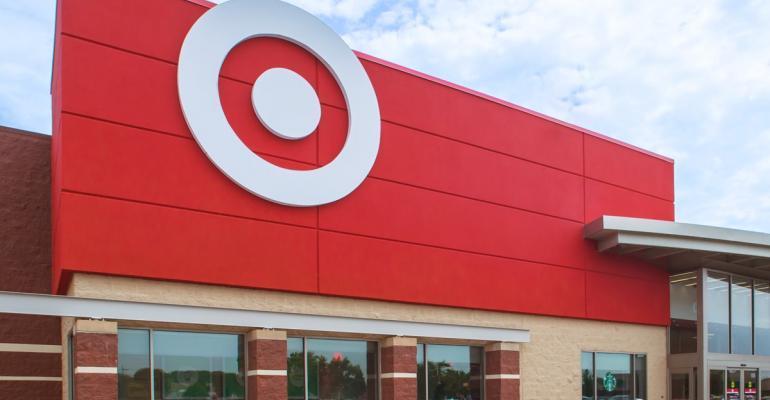Boosted by increased store traffic, Target Corp. generated strong net and comparable sales growth in its fiscal 2021 second quarter, atop big pandemic-fueled gains a year earlier.
Net sales for the quarter ended July 31 came in at $24.83 billion, up 9.4% from $22.7 billion a year ago, Minneapolis-based Target said Wednesday. Overall revenue rose 9.5% to $25.16 billion. Those totals followed growth of 24.8% in net sales and 24.7% in revenue in the fiscal 2020 second quarter, when U.S. consumer spending on food and essential supplies remained elevated due to COVID-19.
Comparable sales rose 8.9% year over year, reflecting gains of 8.7% for stores and 10% for digital channels. That compared with 24.3% comp sales growth in the 2020 quarter, including increases of 10.9% for stores and 195% for digital.

"Guests have emerged from a year in which digital was the primary growth driver, and they're now returning to our stores in droves." — Brian Cornell, Target
“In the second quarter, our business continued to perform and grow on both the top and bottom lines, even as we comped over record performance a year ago,” Chairman and CEO Brian Cornell told analysts in a conference call on Wednesday. “Of course, seeing growth on top of growth is nothing new. Our business was already delivering consistent increases in sales and profitability in the years leading up to the pandemic. This was followed by a dramatic acceleration in 2020 and this year’s continued growth.”
Over the last two years, second-quarter total sales have climbed more than 36%, or more than $6.6 billion, Cornell noted.
“As we described last quarter, guests have emerged from a year in which digital was the primary growth driver, and they're now returning to our stores in droves. As a result, the majority of our second-quarter growth was driven by the stores channel, where comps grew 8.7% on top of 10.9% a year ago,” he said of the 2021 quarter. “In addition, traffic accounted for more than 100% of our second-quarter growth in contrast to a year ago, when guests were limiting time out of their homes and the bulk of our growth was coming from bigger transactions.”
Overall traffic grew 12.7% in the quarter, while the average ticket size shrank 3.4%. Stores fulfilled nearly 97% of sales. On a two-year stack, in-store sales were up more than 20%, according to Chief Financial Officer Michael Fiddelke.
“With guests spending more time out of their homes, we’ve seen them shopping more often and making slightly smaller trips,” Fiddelke said in the call. “Given that last year’s comp growth was primarily driven by average ticket, on a two-year basis, we’ve seen double-digit increases in both traffic and ticket since 2019.”
E-commerce accounted for 17% of Target’s 2021 second-quarter sales. Digital comp sales advanced 10%, adding to 195% growth in the 2020 quarter. Same-day services — Order Pick Up (in-store), Drive Up (curbside pickup) and Shipt (on-demand delivery) — saw 55% comp-sales growth on top of a 270% gain a year ago.
By service, comp sales increased more than 80% for Drive Up, over 30% for Order Pick Up and about 20% for Shipt in the 2021 quarter.
“Given their rapid expansion, same-day services now account for well over half of our digital sales,” Cornell said. “Among those same-day options, Drive Up has quickly grown to be the largest, accounting for more sales than Pick Up and Shipt combined. To put it in dollar terms, over the last two years, second-quarter sales through Drive Up alone have increased by nearly $1.4 billion, and for the spring season, it expanded by double that amount.”

Sales from Target's Drive Up curbside service account for more than that of in-store Order Pick Up and Shipt delivery combined.
Among product categories, apparel led with mid-teens sales growth, followed by food and beverage (low double-digit growth), essentials and beauty (high single digits), hardlines (mid single digits) and home (low single digits). The latter two categories experienced moderated growth after hefty gains a year ago, Cornell noted.
“Notably, we continue to benefit from an impressive performance across our less discretionary food and beverage and essential categories,” he said. “These categories have been consistently delivering strong growth and market share gains, both in 2020 and again this year.”
In food, the bakery, cafe and deli businesses — closed during part of the 2020 second quarter — turned in the top performances, with combined sales up more than 50%, Chief Growth Officer Christina Hennington reported.
“We also saw double-digit growth in our fresh categories, benefiting from an expansion in the number of items available for Drive Up,” she said in the call. “In fact, nearly half of this year’s growth in our produce business has been driven by the growth in Drive Up orders.”
Target has been expanding the product selection available via click-and-collect service, Chief Operating Officer John Mulligan said. “We continue to find ways to enhance our industry-leading Pick Up and Drive Up capabilities,” he told analysts. “In the second quarter, we added another 5,000 items to the assortment available for Pick Up and Drive Up, ranging from items in adult beverages to fresh, pet food, meal kits and greeting cards.”

Target's food and beverage category posted low double-digit comp-sales growth in the second quarter, including the fresh food segment.
Private-brand sales also remain strong, especially for food brands Good & Gather and Favorite Day, according to Hennington. “In the second quarter, own-brands sales outpaced the company, with growth in the mid-teens,” she said. “And in food and beverage, we’re seeing tremendous growth in Good & Gather and encouraging results in our new brand, Favorite Day. We saw an increase in own-brand penetration of about 70 basis points compared with last year.”
On the earnings side, Target reported 2021 second-quarter net income of $1.82 billion, or $3.65 per diluted share, compared with $1.69 billion, or $3.35 per diluted share, a year earlier. Adjusted net earnings per share (EPS) were $3.64 (diluted) versus $3.38 in the prior-year period.
“On the bottom line, we earned second quarter adjusted EPS of $3.64, up nearly 8% compared with last year and double our performance two years ago,” Cornell said.
Analysts, on average, had forecast Target’s second-quarter adjusted EPS at $3.49, with estimates ranging from $3.11 to $4.10, according to Refinitiv.
“Our properties team has had a busy year, as they ramp up our remodel program following last year’s temporary suspension,” Mulligan said in the call. “In addition, they’re working to open new neighborhood stores, distribution centers and sortation centers across the country.”
This year, Target aims to finish about 140 remodels — over 100 are under way — and complete “an even higher number” in 2022.
“The team has also opened 19 new stores this year, spanning from three more stores in New York City to all the way across the country in Hollywood [Calif.],” according to Mulligan. “We’re on track to open 12 more stores this fall, including a new location in Orlando [Fla.] adjacent to Disney World, a new site in Hawaii and a campus location in Madison, Wis.”
Target opened two new distribution facilities, one in New Jersey and another near Chicago, during the second quarter. “And to support our Ship from Store capability, the team is getting ready to open two new sortation centers in October, followed by two more after the holidays,” Mulligan said. “These new facilities offer faster delivery times at a lower cost in markets with a high-density of shipments. In addition, they free up backroom space at store locations they serve, expanding capacity for more digital growth over time.” Following up the Minneapolis pilot location opened last year, the new sortation centers are slated for Houston, Dallas, the Philadelphia area and Lawrenceville, Ga.
Target closed out the second quarter with 1,909 stores overall, compared with 1,871 a year ago. Of its brick-and-mortar base, 1,510 stores are 50,000 to 169,999 square feet, 273 locations are 170,000 square feet or more, and 126 stores are 49,999 square feet or less. Thirty-two of the 38 net-new locations were small-format stores, less than 50,000 square feet.





